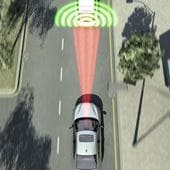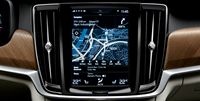Drive-E
City Safety
One of the most comprehensive scientific studies performed on collision avoidance systems in cars reveals that Volvo Cars’ standard City Safety technology reduces insurance claims for rear-end frontal collisions by 28 percent.
Cutting accident claims by 28 percent
Based on real-life accumulated insurance claims data from the Swedish insurers If and Volvia, the study of City Safety performance conclusively reveals the real-life value of auto braking collision avoidance systems.The main benefit of City Safety is its ability to reduce the incidence of whiplash and other neck-related injuries caused by low-speed traffic accidents. The secondary benefit to Volvo car drivers is a reduction in accident damage to their cars and the costs that this incurs.

Magdalena Lindman - Technical Expert, Traffic Safety Data Analysis at Volvo Cars
"Volvo Cars launched its first collision avoidance technology in 2006. City Safety was introduced as standard in all new Volvo car models from 2008."
Strong statistical sample
The study is based on robust insurance company data which covers over 160,000 vehicle years in traffic making it unique in the study of collision avoidance systems. Unlike police or emergency response sourced data, insurance company data covers all accidents – regardless of whether people are injured, giving a more holistic overview of the real-life performance of Volvo Cars’ standard City Safety technology.The figures from the study show that cars equipped with the first two generations of City Safety (active automatic braking up to 18/31 mph in certain traffic situations) were involved in 28 percent fewer accidents and subsequent insurance claims.
Cheaper insurance
Volvo Cars’ City Safety technology also delivers more immediate benefits to Volvo drivers, with insurance companies offering discounts of between 20-25 percent on insurance premiums on several markets thanks to this innovative technology.
Collision avoidance systems are increasingly popular with motorists that spend a lot of time behind the wheel in stop-and-go commuting traffic where the risk for low speed collisions is quite high. Volvo Cars introduced City Safety as standard in new models from 2008. The first generation of the technology worked at speeds up to 18 mph. This was subsequently increased to 31 mph from 2013. In 2015, City Safety has been updated in the XC90 and now operates at all speeds*.
*Applicable only to new XC90s. In all other current Volvo models City Safety operates at up to 31 mph.
Collision avoidance systems are increasingly popular with motorists that spend a lot of time behind the wheel in stop-and-go commuting traffic where the risk for low speed collisions is quite high. Volvo Cars introduced City Safety as standard in new models from 2008. The first generation of the technology worked at speeds up to 18 mph. This was subsequently increased to 31 mph from 2013. In 2015, City Safety has been updated in the XC90 and now operates at all speeds*.
*Applicable only to new XC90s. In all other current Volvo models City Safety operates at up to 31 mph.
A step closer to autonomous cars
“We see our continuous development of collision avoidance and steering assist systems as stepping stones towards autonomous cars. Volvo Cars is already at the forefront of autonomous car development and our huge credibility in car safety is a major advantage. We believe that collision avoidance systems will be an enabler for cars that do not crash and allow people the freedom to drive or be driven in comfort to their destination,” concluded Magdalena Lindman.With Volvo Cars’ long held Vision 2020 the Swedish car maker aims to deliver cars in which no one is seriously injured or killed by the year 2020. Their longer term goal is to design cars that do not crash.
The results of this independent study of the advancements and efficiency of Collision Avoidance Systems (were delivered in conjunction with the 24th ESV (Enhanced Safety of Vehicles) Conference in Gothenburg (June 8-11).
Our Innovations
Everything we do is designed around people, so every innovation we make is designed to simplify and improve your life. We're especially proud of our advances in efficient power, connectivity and safety. We call our thinking in these areas: Drive-E, Sensus and IntelliSafe.


